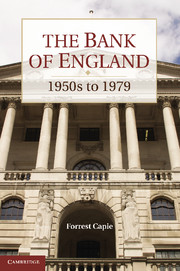Book contents
- Frontmatter
- Contents
- List of Illustrations
- List of Figures
- List of Tables
- Foreword by Mervyn King
- Preface
- Acknowledgements
- Abbreviations and Acronyms
- 1 Introduction and Overview
- 2 The Bank in the 1950s
- 3 The Monetary Setting and the Bank
- 4 The Bank's External Responsibilities to 1964
- 5 From Crisis to ‘Crucifixion’
- 6 Domestic Monetary Policy after Radcliffe
- 7 Other Activities and Performance
- 8 Sterling from Devaluation to Smithsonian
- 9 The Road to Competition and Credit Control
- 10 Competition and Credit Control
- 11 The Secondary Banking Crisis
- 12 Banking Supervision
- 13 Monetary Targets and Monetary Control
- 14 The Bank and Sterling in the 1970s
- 15 The Bank's Freedom to Operate
- 16 Epilogue
- Bibliography
- Index
- Titles in the series
9 - The Road to Competition and Credit Control
Published online by Cambridge University Press: 05 July 2011
- Frontmatter
- Contents
- List of Illustrations
- List of Figures
- List of Tables
- Foreword by Mervyn King
- Preface
- Acknowledgements
- Abbreviations and Acronyms
- 1 Introduction and Overview
- 2 The Bank in the 1950s
- 3 The Monetary Setting and the Bank
- 4 The Bank's External Responsibilities to 1964
- 5 From Crisis to ‘Crucifixion’
- 6 Domestic Monetary Policy after Radcliffe
- 7 Other Activities and Performance
- 8 Sterling from Devaluation to Smithsonian
- 9 The Road to Competition and Credit Control
- 10 Competition and Credit Control
- 11 The Secondary Banking Crisis
- 12 Banking Supervision
- 13 Monetary Targets and Monetary Control
- 14 The Bank and Sterling in the 1970s
- 15 The Bank's Freedom to Operate
- 16 Epilogue
- Bibliography
- Index
- Titles in the series
Summary
When the intention to introduce ‘Competition and Credit Control’ (CCC) was announced in May 1971, it presaged the biggest change in monetary policy since the Second World War. Moreover, when announced, it marked a decisive shift in policy rather than the gradualism that generally characterised the Bank. Several strands came together. There was a growing dissatisfaction with controls and a developing interest in the need for greater competition in banking. And the work on money that suggested a stable demand function pointed to a greater role for interest rates in the control of money growth. There was some acceptance, under pressure, of the need to use open market operations. However, the road from the mid-1960s to 1971 was far from even.
Disaffection with Controls
Over the course of the 1960s, the Bank had become increasingly disaffected with controls and particularly with ceilings on advances. At base, it did not believe in them: they were inequitable, they were difficult to enforce, there were simply too many loopholes, and they soured relations with the banks and the Treasury. All of this had been demonstrated before 1967 and would continue up to 1970, when controls remained the main weapon of domestic monetary policy.
Lending ceilings for the clearing banks had been lifted in April 1967, only to be re-imposed at the time of devaluation when the clearers were asked to cap advances at the 15 November 1967 level.
- Type
- Chapter
- Information
- The Bank of England1950s to 1979, pp. 427 - 482Publisher: Cambridge University PressPrint publication year: 2010



